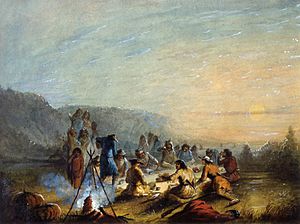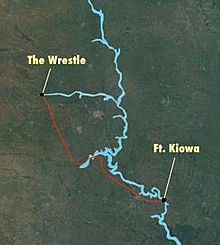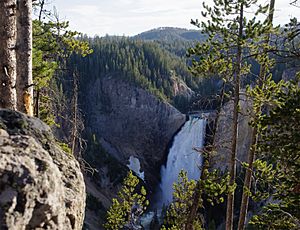Hugh Glass facts for kids
Quick facts for kids
Hugh Glass
|
|
|---|---|

A picture depicting Glass being attacked by a bear, from an early newspaper illustration of unknown origin
|
|
| Born | c. 1783 Scranton, Pennsylvania, U.S.
|
| Died | 1833 (aged approximately 50) |
| Other names | Old Hugh, Old Rinoe, Old Glass |
| Occupation | Frontiersman, trapper, fur trader, hunter, explorer |
| Employer | Rocky Mountain Fur Company, Jean Lafitte, self-employed |
| Known for | Surviving a grizzly bear attack |
| Spouse(s) | Unknown |
Hugh Glass (around 1783 – 1833) was an American frontiersman, fur trapper, trader, hunter, and explorer. He is famous for his amazing story of survival. He was attacked by a grizzly bear and left for dead by his friends. But he survived and even forgave those who left him.
Hugh Glass was likely born in Pennsylvania. He explored the Upper Missouri River area. This is in what we now call Montana, the Dakotas, and Nebraska. His life story has inspired two movies: Man in the Wilderness (1971) and The Revenant (2015). These films show Glass's struggle to survive. He crawled and stumbled about 200 miles (320 km) to Fort Kiowa, South Dakota. This happened after he was left alone without supplies or weapons.
Many people love Hugh Glass's story. However, some parts might not be completely true. The story was first written down in 1825. It was published in a magazine as a fictional piece. It was later picked up by newspapers. It's believed that the story became more dramatic over time.
Contents
Early Life of Hugh Glass
Hugh Glass was born in Pennsylvania. His parents were from Ireland. Not much is known for sure about his early life. Many stories about his time as a frontiersman might have been made more exciting.
One story says he was captured by pirates in 1816. This happened off the coast of Texas. He was supposedly forced to be a pirate for up to two years. Glass then escaped by swimming to shore near what is now Galveston, Texas. Another rumor says he was captured by the Pawnee tribe. He lived with them for several years. In 1821, Glass traveled to St. Louis, Missouri. He went with some Pawnee leaders who were meeting with U.S. officials.
Joining General Ashley's Expedition

In 1822, General William Henry Ashley put an ad in a newspaper. He was looking for 100 men to travel up the Missouri River. This was for a fur-trading business. Many famous mountain men joined this group. These included James Beckwourth, William Sublette, and Jim Bridger. They were known as "Ashley's Hundred".
Hugh Glass joined Ashley's group the next year, in 1823. They traveled up the Missouri River. In June 1823, they met up with the other men. They were then attacked by Arikara warriors. Glass was shot in the leg during this attack. The survivors went back downstream and asked for help.
Glass wrote a letter to the parents of a young man named John S. Gardner. John was killed in the attack on June 2, 1823.
Dear Sir:
It is my sad duty to tell you about your son's death. He was killed by Indians on June 2nd in the early morning. He died soon after he was shot. He asked me to tell you what happened. We brought him to the ship, and he passed away there.
Mr. Smith, a young man with us, said a powerful prayer. It touched us all deeply. I believe John died peacefully. We buried his body with others near our camp. We marked his grave with a log. We will send his belongings to you.
The Native Americans are very tricky. We traded with them as friends. But after a big storm, they attacked us before dawn. Many of us were hurt. I was shot in the leg. Master Ashley plans to stay here until these attackers are punished.
Your obedient servant, Hugh Glass
The Grizzly Bear Attack
After the attack, Glass and Ashley's group went back to Fort Kiowa. They needed to get ready for their trip west. Andrew Henry, Ashley's business partner, joined them. Henry, Glass, and others set out overland towards the Yellowstone River.
Near the Grand River, Glass was looking for animals to hunt. He surprised a mother grizzly bear with her two cubs. The bear charged at him. It bit, slashed, and badly wounded him. Glass was thrown to the ground. With help from his group, Glass managed to kill the bear. But he was severely injured.
The men thought Glass would not survive. They carried him on a stretcher for two days. But this made them travel very slowly. Henry asked for two volunteers to stay with Glass until he died and then bury him. John S. Fitzgerald and a man known as "Bridges" volunteered. The rest of the group moved on. Fitzgerald and Bridges started digging Glass's grave.
Later, they claimed that Arikara warriors attacked them. They quickly took Glass's rifle, knife, and other gear. Then they ran away. Fitzgerald and Bridges later met up with the main group. They wrongly told Ashley that Glass had died. There is some debate if "Bridges" was actually the famous mountain man Jim Bridger.
Hugh Glass's Incredible Survival
Despite his terrible injuries, Glass woke up. He found himself alone, without weapons or supplies. He had many wounds, a broken leg, and deep cuts. Glass was more than 200 miles (320 km) from the closest American settlement. That was Fort Kiowa, on the Missouri River.
Glass bravely set his own broken leg. He wrapped himself in the bear hide his companions had left over him. Then, he began to crawl back to Fort Kiowa. He used Thunder Butte as a guide. Glass crawled south towards the Cheyenne River. There, he built a simple raft. He floated downstream to Fort Kiowa. This amazing journey took him six weeks. He survived mostly by eating wild berries and roots.
Searching for Fitzgerald and Bridges
After he got better, Glass set out to find Fitzgerald and "Bridges." He eventually reached Fort Henry on the Yellowstone River. But it was empty. A note said that Andrew Henry and his group had moved to a new camp. This new camp was at the mouth of the Bighorn River.
When Glass arrived there, he found "Bridges." But Glass seemed to forgive him because he was so young. Glass then rejoined Ashley's company.
Glass later learned that Fitzgerald had joined the army. He was stationed at Fort Atkinson in Nebraska. Glass reportedly spared Fitzgerald's life. This was because an army captain would have killed Fitzgerald for harming a soldier. The captain made Fitzgerald return Glass's stolen rifle. Before leaving, Glass warned Fitzgerald never to leave the army. If he did, Glass said he would still kill him. Some stories say Glass also received $300 as payment.
More Adventures with General Ashley
In February 1824, Glass and four others were sent to deliver mail to Fort Atkinson. They traveled up the Powder River. Then they went across to the Platte River. There, they made boats out of animal skins. They traveled down the Platte River.
Glass and his group found a village of 38 Arikara lodges. Their leader, whom Glass knew, said the tribe was friendly. He invited them in. While smoking with the leader, Glass noticed their equipment being taken. He realized it was a trap. The men quickly ran away. But two were killed by the chasing warriors. Glass managed to hide behind some rocks until the Arikara stopped looking. He was separated from the two other survivors. He was glad to find his knife and flint. He traveled to Fort Kiowa, surviving on his own.
Glass returned to the frontier as a trapper and fur trader. He later worked as a hunter for the U.S. Army at Fort Union. This was near Williston, North Dakota.
Death
Hugh Glass was killed in early spring of 1833. He was with two other trappers on the Yellowstone River. They were attacked by the Arikara.
Today, there is a monument to Hugh Glass. It stands near where he was mauled by the bear. This is on the southern shore of the Shadehill Reservoir in Perkins County, South Dakota. The Hugh Glass Lakeside Use Area is also nearby. It is a free campground and picnic area.
Hugh Glass in Books and Movies
Glass's life story has been told in many books and dramas.
- "The Song of Hugh Glass" (1915) is a long poem by John G. Neihardt.
- Lord Grizzly (1954) is a book about Glass's ordeal by Frederick Manfred.
- In 1966, the TV show Death Valley Days had an episode called "Hugh Glass Meets the Bear." John Alderson played Glass.
- The film Man in the Wilderness (1971) is loosely based on Glass's story. It stars Richard Harris as Zachary Bass.
- Dewitt Lee played Sam Glass in Apache Blood (1975), another film based on Glass's story.
- Author John Myers Myers wrote The Saga of Hugh Glass: Pirate, Pawnee, and Mountain Man in 1976.
- Roger Zelazny and Gerald Hausman combined the stories of John Colter and Glass in their 1994 novel Wilderness.
- Hugh Glass, Jim Bridger, and Tom Fitzpatrick appear in The Wandering Hill: Volume 2 of the Berrybender Narratives by Larry McMurtry (2003).
- The song "Six Weeks" by Of Monsters and Men was inspired by Hugh Glass's true story.
- Michael Punke's 2002 novel, The Revenant, is a fictional retelling of Glass's bear attack and his search for revenge.
- A 2014 episode of the podcast The Dollop talks about Hugh Glass.
- The TV show Monument Guys featured the building of a sculpture of Glass and a bear in 2015.
- Sculptor John Lopez made a life-size sculpture of Hugh Glass being attacked by a Grizzly. It is at the Grand River Museum in Lemmon, SD.
- Leonardo DiCaprio played a version of Glass in the 2015 film The Revenant. The film was very popular. It won 12 Academy Award nominations. DiCaprio won his first Academy Award for Best Actor for this role.
- Hugh Glass appears in World of Warcraft as a merchant with his bear, Griselda.
- The book "Cowboys, Mountain Men, & Grizzly Bears" by Matthew P. Mayo has a chapter about Hugh Glass.
See also
 In Spanish: Hugh Glass para niños
In Spanish: Hugh Glass para niños




